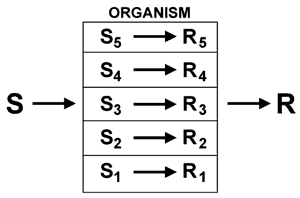Crossing Curves:
3. Discriminative Learning
Processing in the Information Age was based upon the sharing of conditioned responses. The Information Age defined its requirements in terms of “participative learning.†The leaders analyzed the data and synthesized the factors directing an organization’s activities. The performers “participated†in considering alternative goals and courses of action and in operationally defining these goals and technologically developing the programs to achieve the goals. The performers drew from a repertoire of shared responses to formulate the responses most appropriate to the stimuli.
In this context, the difference between conditioning and learning is the intervening organism:

The organism intervenes to mediate or transform the stimulus material into appropriate responses. Of course, in order to make an appropriate response, it is assumed that the organism has a repertoire of responses.
Indeed, it is assumed that the individual organism is defined by a set of conditioned responses (S → R) (see Figure 3). In other words, the individual acquires a set of responses that he or she draws from to respond to the stimuli. Depending upon the stimuli, the individual possesses a hierarchy of responses in readiness to respond. The individual discriminates the stimuli and formulates one or more responses that are appropriate to the stimuli.

Figure 3. The S–O–R Discriminative Learning Paradigm
Our responses to others at home, school or work are, at once, drawn from our response hierarchy and calculated to facilitate increasing our response hierarchy. It is critical to understand that the intervening organism’s “intelligence†is derived from the extensiveness of its repertoire of responses and the accuracy of the ability to discriminate the stimuli. Learning is predicated upon the principle of expanding the response repertoire. Participative learning is predicated upon sharing and participating in selecting responses with others. In some cases, individuals and groups may negotiate new responses based on an integration of conditioned responses. However, individuals or groups are always limited by their conditioned repertoires of responses.
